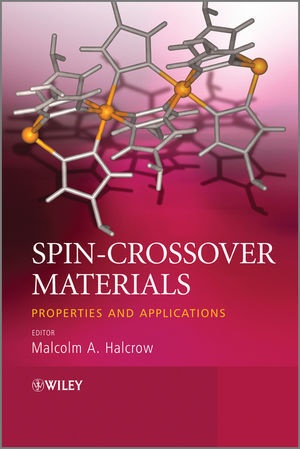En savoir plus
Informationen zum Autor Malcolm Halcrow, Professor of Inorganic Chemistry, University of Leeds, UK Professor Halcrow's independent research has spanned different areas of synthetic inorganic chemistry, but with particular interests in switchable metal complexes, supramolecular chemistry and crystal engineering. The synthesis and structural chemistry of spin-crossover materials has been his most active research area in the past ten years; since his first paper in the field in 2001, Professor Halcrow has published 34 papers directly related to spin-crossover, including three journal reviews which are widely cited in the spin-crossover literature. Klappentext The phenomenon of spin-crossover has a large impact on the physical properties of a solid material, including its colour, magnetic moment, and electrical resistance. Some materials also show a structural phase change during the transition. Several practical applications of spin-crossover materials have been demonstrated including display and memory devices, electrical and electroluminescent devices, and MRI contrast agents. Switchable liquid crystals, nanoparticles, and thin films of spin-crossover materials have also been achieved.Spin-Crossover Materials: Properties and Applications presents a comprehensivesurvey of recent developments in spin-crossover research, highlighting the multidisciplinary nature of this rapidly expanding field. Following an introductory chapter which describes the spin-crossover phenomenon and historical development of the field, the book goes on to cover a wide range of topics including* Spin-crossover in mononuclear, polynuclear and polymeric complexes* Structure: function relationships in molecular spin-crossover materials* Charge-transfer-induced spin-transitions* Reversible spin-pairing in crystalline organic radicals* Spin-state switching in solution* Spin-crossover compounds in multifunctional switchable materials and nanotechnology* Physical and theoretical methods for studying spin-crossover materialsSpin-Crossover Materials: Properties and Applications is a valuable resource for academic researchers working in the field of spin-crossover materials and topics related to crystal engineering, solid state chemistry and physics, and molecular materials. Postgraduate students will also find this book useful as a comprehensive introduction to the field. Zusammenfassung Beginning with an introductory chapter describing the spin-crossover phenomenon and a historical overview of the field since it was first observed in the 1930s, this book looks at recent advances in the chemistry of traditional spin-crossover complexes and materials containing iron(II), iron(III) or cobalt(II). Inhaltsverzeichnis List of Contributors xv Preface xvii 1 The Development of Spin-Crossover Research 1 Keith S. Murray 1.1 Introduction 1 1.2 Discrete Clusters of SCO Compounds 4 1.3 1D Chains of FeII SCO Materials 22 1.4 1D Chains of FeIII SCO Materials 28 1.5 2D Sheets of FeII SCO Materials 29 1.6 3D Porous SCO Materials 30 1.7 Some Recent Developments in Mononuclear SCO FeII, FeIII and CoII Compounds 33 1.8 Multifunctional/Hybrid SCO Materials 37 1.9 Developments in Instrumental Methods in Spin-Crossover Measurements 40 1.10 Applications of Molecular Spin-Crossover Compounds 41 1.11 Summary 42 2 Novel Mononuclear Spin-Crossover Complexes 55 Birgit Weber 2.1 Introduction and General Considerations 55 2.2 Novel Coordination Numbers (CN), Coordination Geometries and Metal Centres 57 2.3 Iron Complexes with Novel Ligand Donor Atoms and New Ligand Systems 65 2.4 Other Examples 70 2.5 Conclusion and Outlook 72 3 Spin-Crossover in Discrete Polynuclear Complexes 77 Juan Olguin and Sally Brooker 3.1 Introduction ...

